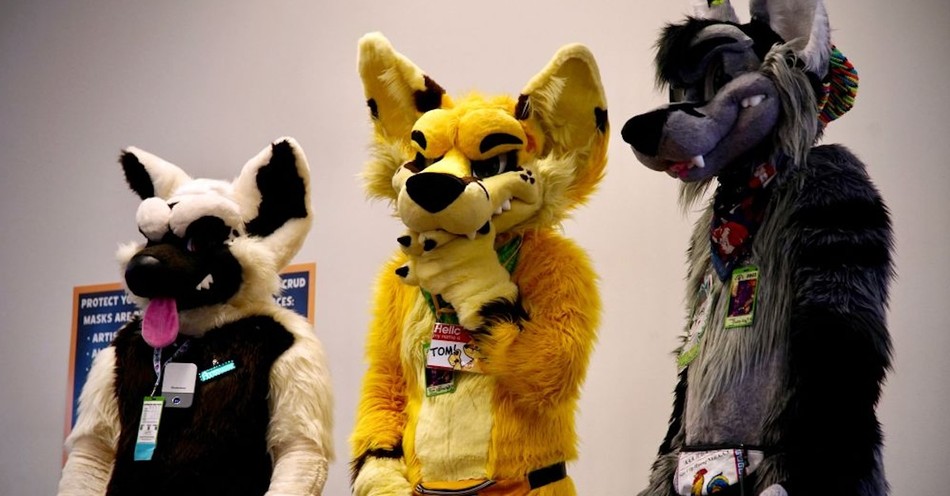This weekend, I went to the Renaissance Festival in my town. There were a lot of people wearing costumes and dressed up. I purchased a tiara to wear, and my son wore a crown. After all, it’s the type of event that invites people to step into a different time or into a fantasy and participate through dress up or role-play. It’s just for fun for a moment, or a weekend. I love an excuse to wear a costume or play dress up for a theme. I’ve had a blast playing characters in skits. At the end of the day, I’m still me. I am not trying to escape being me or hide. I don’t see these costumes or characters as an extension of my persona. I do not need to dress up to find my identity, nor do I find my identity in a costume. A costume, by nature, introduces a counterfeit identity. Costumes hide something and portray something else, separate from the truth or reality. But what if the line between a character and personal identity gets blurred?
Furry fandom is full of people who are drawn to and fascinated by anthropomorphic animals, animals with humanlike qualities (examples include Mickey Mouse or the Paw Patrol). Many “furries” develop their own anthropomorphic characters and dress up in elaborate costumes. This isn’t just fascination, but participation. At first, it can sound like another excuse to dress up, but it goes much deeper than that. Furry fandom is about not being tied down to the person you are or were born as, but escaping that and replacing it with who one wishes to be. It is adopting a character as one’s own identity, an identity freed to come out through cos-play. The “fursona” is a pathway to personal exploration, communication, intimacy, and belonging.
One member of the furry fandom says it “is mostly about creating a safe space…for those who want to explore parts of themselves that they don’t normally feel comfortable exploring.”
According to sociologist Dr. Sharon Roberts, Furry Fandom attracts those who are vulnerable, many of whom have experienced being bullied at times in their lives. The experience of pain and rejection is running underneath the surface, looking for safety. This safety comes from anonymity. Dressing up as an anthropomorphic animal, especially with a mask or head covering, makes the wearer anonymous. It is under this anonymous identity that one no longer feels bound by social restrictions or rejections. Furry fandom finds freedom in hiding and pretending to be something else or something more.
Safety is found in hiding. Some may call it authenticity–that in dressing up in costume, one may only truly feel to be who they want, with who they want, how they want, where they want. They may say the authenticity is drawn out by the costume. But hiding is hiding. What kind of freedom requires being hidden? Being anonymous is to remain unknown. Being unknown does not allow us to be fully loved. Even if someone loves a character we play, it does not mean they love us. They love an idea or personality we created. But maybe for some, even having someone love a character we play is better than risking outright rejection or receiving no love at all. It is settling for a counterfeit love rather than no love.
But the other side of the conversation is examining the question: what environments or interactions have made people feel so insecure or scared that they retreat into wearing costumes in order to communicate or find intimacy, even false versions? What has happened in someone’s life that makes them feel they need to hide? Where did a connection develop between being seen and feeling pain? When we understand this journey, we understand why the journey took place and maybe a little about how one got here.

It makes me think of famous “hiders” in the Bible:
1. Adam and Eve (Genesis 3:7-10)
God was walking in the Garden of Eden and called to Adam, asking where he was. Adam heard God coming, and because he was afraid, he hid. He was afraid to be seen fully. He had been naked with God before, but something changed when sin entered the picture, and now Adam hid his nakedness. Shame, embarrassment, and fear dance together in Adam’s reality, and he hides from the One who offers real love and real safety. Hiding did not protect Adam from shame, but trapped him in shame. Putting on fig leaves did not make him free, but was a symbol of the new distance he felt from God. God did not point at the fig leaves and yell, “Take that off! That’s not you!” Instead, we know God designed a large plan to deal with sin. The fig leaves weren’t the problem. The sin that birthed wearing the fig leaves was the problem.
2. Zacchaeus (Luke 19:1-4)
Zacchaeus heard about Jesus and wanted to see Jesus for himself. As a chief tax collector and a short man, climbing a sycamore-fig tree is a logical solution to a social problem. Zacchaeus needs a higher vantage point, so he climbs a tree. Zacchaeus is also disliked by the crowd around Jesus, and so climbing a tree protects him from the crowd. He hides to see Jesus, but Jesus calls to Zacchaeus to come down and spend time together. The crowd disapproves, and their rejection of Zacchaeus is expressed as they refer to him as a “sinner.” Being with Jesus changes Zacchaeus into a man who seeks to set things right and be generous.
3. The Disciples (John 20:19)
After the death of Jesus Christ, the disciples hid, locking themselves in an upper room. They were afraid of the Jewish leaders. If the Jewish leaders could have Jesus crucified, then perhaps they were next. The disciples had put their hope and faith into Jesus. They had left everything to follow Jesus, and now Jesus was dead. I can only imagine what I would feel in that moment: loss, sadness, disappointment, anger at myself for being misled, foolish, scared, confused, and desperate. I would want to hide until I knew what to do next, until I had a plan. Jesus shows up in the locked room with the good news that He is alive! The disciples are overjoyed!
Each of these examples reveals hiding as a result of pain, shame, or fear. Many in Furry Fandom share similar stories of pain, shame, and fear ,drawing them into a costume and character. What can the Church offer those who are hiding? In each of the biblical scenarios, God finds those who are hiding in their hiding place and then draws them out of that hiding place. When one is stuck, believing that hiding is the best solution to their pain problem, God offers a different way. What does it look like for the church community to be a place where people can come out of hiding? In truth and love, we can share that they do not need to settle for counterfeit love. They can be truly seen and known, with no need for a costume. In Christ, God changes us and forms us to reflect more of Him. We don’t need to wish we were different people because in God’s hands, we become different people.
We may meet someone’s “fursona” and see that person hiding in plain sight. Before offering rejection, we can be curious about the pain, shame, or fear that brought this person to this point. And the best part is, we carry the Good News of Jesus Christ, who also sees each person in every form of hiding place, and invites each person to know real, healing love.
Photo Credit: ©GettyImages/AGNES BUN / Contributor





